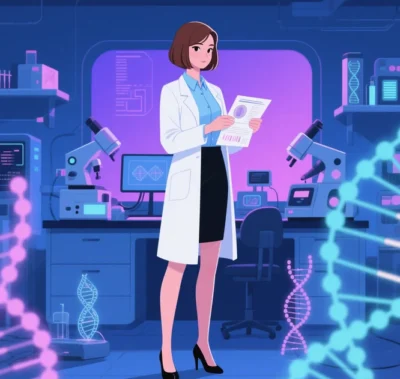
Technological Applications and Case Studies of Gene Codons
Gene codons, the core units of genetic information transfer, have applications spanning basic research to industrial translation. Below, we analyze their value through codon optimization, genetic code expansion, biomedical applications, industrial/synthetic biology use cases, and future challenges.
1. Codon Optimization: Enhancing Gene Expression Efficiency
Codon optimization tailors codon usage frequency in gene sequences to match host organism preferences, significantly improving protein expression efficiency. This technology is widely used in recombinant protein production, synthetic biology, and gene therapy.
Algorithms and Tools
- GenSmart Optimization: A GenScript-developed online tool that optimizes sequences based on species-specific Codon Adaptation Index (CAI). For example, optimized VH and Vk sequences increase antibody expression in E. coli by 3-5x.
- coRdon Package: An R-language tool calculating metrics like Effective Number of Codons (ENC) and codon bias to predict gene expression levels. Its MELP algorithm identifies highly expressed genes in metagenomic analysis.
- NGTM Algorithm: Synbio Technologies’ proprietary algorithm clusters codon usage frequencies, reducing GC content and repetitive sequence issues by over 50%.
Industrial Applications
- Recombinant Protein Production: Optimized insulin genes in yeast achieve 200% higher yields than native sequences.
- Synthetic Biology Chassis: Codon-optimized cyanobacteria boost ethylene synthesis efficiency by 30%, serving as sustainable plastic feedstock platforms.
- Vaccine Development: Codon-optimized mRNA for COVID-19 vaccines improves human cell translation efficiency by 70% while lowering immunogenicity.
2. Genetic Code Expansion: Beyond Natural Amino Acids
Genetic Code Expansion (GCE) repurposes stop or rare codons to incorporate non-canonical amino acids (ncAAs), enabling atomic-level control over protein functions.
Core Methods
- Orthogonal Translation Systems: Engineered aminoacyl-tRNA synthetase (aaRS) and tRNA pairs assign ncAAs to specific codons (e.g., amber codon UAG). The pyrrolysine system by Schultz Lab is used in mammalian cells.
- Light/Chemical Control: Deiters Lab integrated photo-sensitive lysine (PCK) into Cas9 for spatiotemporal gene editing via UV activation.
Biomedical Applications
- Antibody-Drug Conjugates (ADCs): Site-specific AzF incorporation enables click chemistry-based toxin conjugation. Seagen’s HER2-targeted DS-8201 shows 60% clinical response rates.
- Gene Editing Tools: Liu Lab inserted AcF into Cas12, quadrupling editing efficiency for CAR-T therapies.
- Long-Acting Therapeutics: PEGylation sites in interferon β extend half-life from 5 to 130 hours.
3. Biomedical Breakthroughs
Disease Mechanism Research
- Pathogen-Host Interactions: Chen Lab used photo-crosslinking ncAAs in gut pathogens to dissect acid resistance and toxin secretion pathways, guiding antibiotic design.
- GPCR Signaling: Real-time tracking of GPCR-ligand dynamics via ncAA labeling accelerates neurodegenerative drug development.
Cell and Gene Therapy
- Logic-Gated CAR-T Cells: AND-gate CAR-T cells targeting CD19+CD22+ microenvironments achieve 92% complete remission in B-cell lymphoma.
- Oncolytic Viruses: GM-CSF-expressing vaccinia virus enhances anti-tumor immunity, approved for melanoma treatment.
Vaccine Design
- Live Attenuated Vaccines: ncAA-labeled Salmonella vaccines enable real-time potency monitoring, extending typhoid vaccine protection to 10 years.
4. Industrial and Synthetic Biology Applications
Sustainable Biomanufacturing
- Microbial Factories: Engineered yeast produces cannabinoids at 70% lower cost than plant extraction.
- Cellular Agriculture: Eat Just’s codon-optimized mammalian cells yield lab-grown meat with programmable fat-protein ratios.
Environmental Remediation
- Heavy Metal Biosensors: Phage-engineered bacteria detect and sequester arsenic via metal-responsive promoters and chelating proteins.
- Carbon Capture: Codon-optimized RuBisCO in cyanobacteria fixes CO₂ at 5g/L/day for biodiesel production.
5. Challenges and Future Directions
Current Limitations
- Translation Efficiency: ncAA incorporation rates remain below 20%, necessitating improved orthogonal systems.
- Host Compatibility: Rare codons (e.g., AGG in E. coli) compete with endogenous tRNAs, causing ribosome stalling.
Emerging Technologies
- AI-Driven Design: AlphaFold for RNA predicts RNA structures to optimize gRNA designs, reducing CRISPR off-target rates below 0.1%.
- Quantum-Bio Hybrids: Quantum computing models codon-anticodon interactions to engineer unnatural base pairs (e.g., dNaM-dTPT3).
Ethics and Governance
- Biosafety: The EU’s SynBio-Safety Level (SBSL) mandates physical containment for ncAA-dependent organisms.
- Ecological Risks: Synthetic cyanobacteria require multi-layered kill switches (e.g., temperature-sensitive iCas9 + auxotrophy) to prevent algal blooms.
Conclusion
Gene codon technology is evolving from optimization to reprogramming, permeating biomedicine, manufacturing, and environmental sectors. Over the next decade, AI and quantum computing integration could enable three breakthroughs:
- Whole-Genome Codon Refactoring: Harvard’s Church Lab is designing a 57-codon minimal genome to free coding capacity.
- Dynamic Orthogonal Systems: Light- or pH-responsive GCE systems for real-time protein control.
- Cross-Species Compatibility: Universal translation systems for efficient gene expression across organisms.
This field demands interdisciplinary collaboration and global governance to balance innovation with biosafety, advancing from designing life to designing ecosystems.
Data sourced from public references. For collaboration or domain inquiries, contact: chuanchuan810@gmail.com





